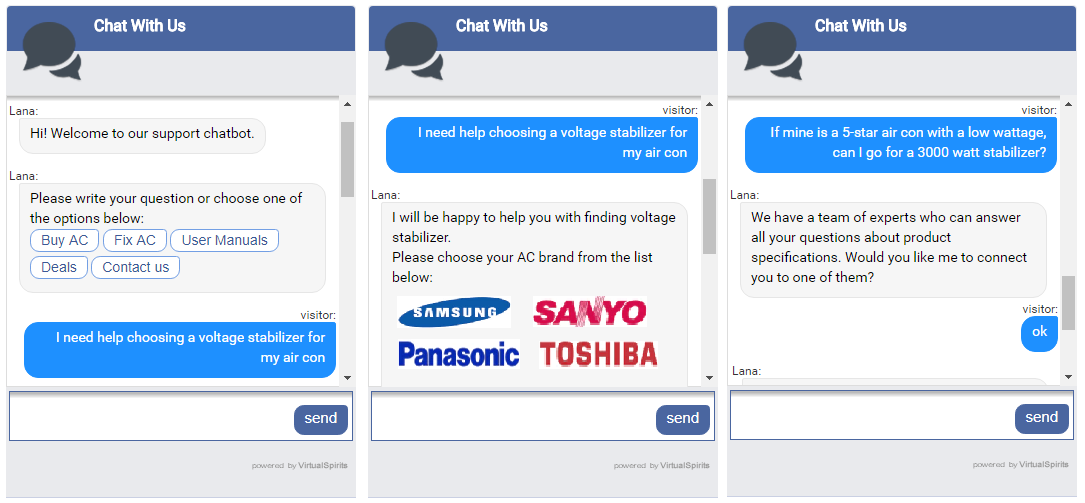
TOPICS:
Chatbot for Support Chatbot for Service Chatbot Optimization
Customer Service Chatbot – How Consumers Want To Use Service Bots
"Does my website need a customer service chatbot?"That may have been a legitimate question for the average business owner a year ago. But fast forward to today, and most business owners have moved on to mulling over the actual specifics of building chatbots for customer support.
It's no secret that customer service chatbots have the potential to improve customer engagement and retention rates. But how d'you ensure that your chatbot brings these benefits to your business? Keep reading for some quick tips on building chabots that your customers would like to interact with.

1. Create a chatbot that solves as many issues as possible.
The recent rise in the global popularity of chatbots has been meteoric, to say the least. And we're just about getting started. Analysts over at Aspect Software predict that the use of chatbots will have risen by 1000% in just two years' time. Even at this moment, 71% of consumers would like to be able to solve the bulk of their customer service issues on their own. And then there's the matter of phone support getting phased out and being replaced by instant messaging.
What the above developments indicate is that people actually want to be able to take their queries and complaints to customer service chatbots. As a business owner, you can cater to this preference by building chatbots that can answer as many support questions as possible. This way, your buyers won't have to depend on phone calls, email support, or online research, to get the answers or assistance they need.
2. Get your chatbot to predict your customers' problems.
People don't always know how to explain the issue they have, or know exactly what they're looking for. For example, Amelia, a 60-year-old customer who has just purchased a Wi-Fi router from your store, isn't too familiar with setting up a network that all her devices can connect to. She also isn't familiar with the terminology used to describe the issue. She expects to have a hard time explaining her problem to your chatbot. But what if your chatbot is programmed to predict users' questions or complaints, based on prior interactions? Sample the following conversation:
Support Chatbot:
"Hey there! Welcome to ABC electronics support desk. What can I help you with today?"Amelia:
"I can't set up my new router."Support Chatbot:
"No problem! I can help you fix that. Are you facing any of the following problems?"Amelia sees a list of issues including "router won't power on", "how to set up a homegroup or office network", "connecting my phone to my Wi-Fi router", and so on. She selects "how to set up a homegroup or office network" and gets a step-by-step tutorial that she can follow.
3. Know when to connect your customers to your human support staff.
Building chatbots for customer service doesn't mean that you no longer have any use for your human support staff. In fact, the best chatbots for customer service know when to recognize their limitations and pass the issue on to a live representative. This system actually makes for a much better use of your available resources, because it ensures that your virtual and human staff are both working on tasks that best match their skills.
As an illustration, let's imagine that 30-year-old Jeff is looking to buy a voltage stabilizer for his new air conditioner. His initial research has presented him with a long list of products, but he doesn't quite understand the parameters he should use to make his final choice. He strikes up a conversation with your store's online chatbot.
Support Chatbot:
"Hi! Can I help you with something?"Jeff:
"I need help choosing a voltage stabilizer for my air con."Support Chatbot:
"I will be happy to help you with finding voltage stabilizer. Please choose your AC brand from the list below. "Jeff chooses his air conditioner brand and model, his voltage supply quality in his building, and so on... At the end of the exercise, the chatbot presents him with a link to matching stabilizers. But Jeff still isn't clear about the choice.
Jeff:
"If mine is a 5-star air con with a low wattage, can I go for a 3000 watt stabilizer?"Support Chatbot:
"We have a team of experts who can answer all your questions about product specifications. Would you like me to connect you to one of them?"Jeff:
"Ok."The customer service chatbot passes Jeff's case on to a live support rep, and Jeff gets his answers. Had the chatbot continued to try and look for matching questions in an attempt to help Jeff, the process might have taken several more iterations and a lot more time. By working in sync with the live support staff, the customer service chatbot achieved a more efficient workflow.
4. Keep adding to your chat script:
When you create a chatbot for customer service, you also create a window into the latest issues and questions that your customers have. This information is invaluable, as it'll keep you up-to-speed with your customers' requirements and preferences. Use it to reassess and improve your chat script from time to time. This way, you'll be able to stay relevant and address the most common issues your customers have at any point in time. Meanwhile, your human staff needn't spend as much time researching the latest queries and complaints, and can focus instead on handling only those complex issues that are beyond the scope of your customer service chatbots.
Create a chatbot for customer service and ready your business for the future. Read our latest blog posts or contact us with your questions about building chatbots for your website.